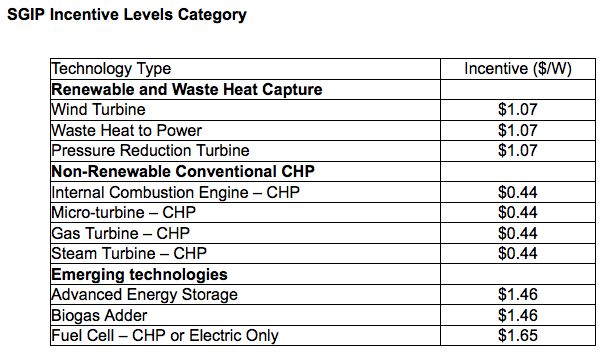In August, GTM reported on the debate at the California Public Utility Commission (CPUC) around the state's Self-Generation Incentive Program that was pitting solar, storage and environmentalists against natural-gas-fired distributed generation.
California's SGIP is a generous subsidy ($83 million per year) intended to spur development of low-emissions distributed generation with upfront and performance-based incentives for eligible behind-the-meter generation technologies. These include wind, gas turbines, combined heat and power, advanced energy storage, biogas and fuel cells. But the CPUC has to decide what "low emissions" actually means now that the state has a 50 percent renewable portfolio standard (RPS) by 2030, as per California SB 350.
Just what qualifies as "low emissions" has been the subject of debate at the CPUC, since the calculation could exclude fuel cells or small gas engines from qualifying. Regulatory folk from the solar, fuel-cell and natural-gas industries have weighed in with their own calculations in letters to the CPUC.
California SB 861 reauthorized the incentive and requires the CPUC to update the factor for avoided greenhouse gases (GHGs) in consideration of the effects of the California RPS. The current proposed decision uses the previous, now-outdated 33 percent RPS. (A PDF file of the proposed decision can be found here.)
The new SGIP GHG Eligibility Factor as defined in the proposed decision of Commissioner Picker "updates the greenhouse-gas emission factor that determines eligibility to participate" in the SGIP from 379 kg CO2/MWh to 360 kg CO2/MWh.
SolarCity and CalSEIA contended at the time that the proposed decision "does not appropriately apply the 33 percent RPS adjustment and will ultimately allow SGIP funds to be spent on resources that will increase, potentially significantly, GHG emissions in California." SolarCity and CalSEIA suggest the figure should be 282 kilograms of CO2 per megawatt-hour.
Bloom Energy's natural-gas-powered fuel cells have drawn or reserved more than $400 million of the program's 14-year $1.4 billion total, according to the CPUC's SGIP worksheet. Bloom's spec sheet lists CO2 emissions of 333 kilograms to 385 kilograms per megawatt-hour.
"PG&E supports the updated GHG emission standard of 360 kg CO2/MWh for eligibility to participate in the SGIP until better analytics can be performed," according to the utility.
There are no significant changes from the decision issued in July (PDF here) to the revised proposed decision issued last week. The CPUC did not respond to a request for comment as to why the avoided GHG calculation would not take into account the 50 percent RPS in the recent proposed decision.
A vote is scheduled at this Thursday’s meeting of the CPUC. That decision will help determine the grid-edge technology mix funded by $300 million of California ratepayer cash over the next few years.
In August, the Calif. legislature weighed in with a pointed letter directed to Commissioner Picker that emphasized the intent of SB 861. The letter stated, "We are deeply disappointed with your proposed decision, which meets neither the letter nor the spirit of the statute." The letter suggests that "the decision appears to be skewed to maintain eligibility for existing technologies operating on 100 percent conventional natural gas," adding, "If your decision is adopted, SGIP will continue the increasingly absurd practice of subsidizing natural gas consumption, supporting existing technologies that have already taken hundreds of millions of dollars from SGIP...without producing substantial efficiency improvements, cost reductions, or general benefits for taxpayers, squandering the $415 million ratepayer investment authorized by SB 861 and undermining our collective efforts to clean the grid and transition away from fossil fuels."

Source: Base SGIP Incentive Levels for Eligible Technologies (from 2015 SGIP Handbook)



